
The major contribution of traffic noise, towards overall noise pollution scenario, is a well known and established fact. Traffic noise from highways creates problem for surrounding areas, especially when there are high traffic volumes and high speeds. Vehicular traffic noise problem is contributed by various kinds of vehicles like heavy, medium trucks/buses, automobiles and two wheelers. Many western countries have developed prediction models based on L10, Leq and other characteristics. In India, the transportation sector is growing rapidly at more than 7.50% per annum and no. of vehicles on Indian roads is increasing at a very fast rate. These lead to overcrowded roads and cause various types of pollutions. Amongst these, Noise pollution is an important type which causes annoyance and health problems to human beings.
This paper analyzes the measurement of traffic noise using the Noise Pollution Level, Traffic Noise Index and Equivalent sound levels by the application of noise level meter SL-4023- SD (with a Real Time Data Logger) for a period of 24 hours for up and down streams on a patch of NH-06. The major conclusions obtained are: higher the volume of traffic noise and speed of stream, the value of L10 varies directly.
The fast growing vehicle population in towns in the recent years has resulted in considerable increase in traffic on roads causing alarming noise pollution. Noise level increases with traffic volume in a exponential manner [1]. In many developing countries like India, traffic noise is a major constituent of environmental pollution and now it becomes a permanent part of urban and sub-urban life [2]. It is very harmful to human beings also.
In the new millennium, for protection against environmental degradation, it is imperative to pay greater attention towards measuring noise pollution, enforcing regulation for noise emission limits, and elimination and control of noise pollution. Noise pollution level was measured in NH-06 and various parameters were determined and are presented briefly in this paper. Highway noise comes from several sources, noise from engines, exhaust systems and the body of the vehicle tends to dominate for low-speed or during accelerating conditions. Tires/pavement noise tends to be most important at typical free way speed. Aerodynamic noise tends to dominate only in very high speed situations that are not common in India. Noise creates interference in communication and health hazards.
The key purpose for conducting this noise study is to monitor and assess the traffic generated noise in its special temporal aspects on highway & evaluation of important noise parameters (such as L10, L50, L90, Leq etc.) and to suggest suitable measures to reduce traffic noise.
As per studies made by P.D. Marathe (2012) in “Traffic Noise Pollution” and Balashanmagam (2013) in “Ambient Noise Level monitoring of the Chidambaram town” and many others have made efforts in measurement & analysis of equivalent continuous noise level (Leq), percentile noise levels (L10, L50, L90) and presented the remedial measures for bringing down the traffic noise in respective regions, similarly an effort has been made on NH-06 passing through C.G. state by analyzing & measuring the various noise level parameters, which helped the investigators to formulate a prediction model.
Road traffic noise is the most important major source of community noise specially near an important road with high volume of traffic of any major city [3]. In developing country like India, where roads are in bad condition ,and poorly maintained and has considerable number of vehicles of outdated technology, the road traffic noise assumes much more importance [4].
There are various factors that affect the traffic noise.
As the traffic flow increase, the noise level increases. Higher speed also causes higher noise levels. At lower speeds, the influence of engine transmission of noise is predominant. On the other hand at higher speed the tire surface interaction assumes to be important. Noise level increases during acceleration.
It is a major generator of noise. Grooved cement concrete pavement is found to be the source of annoying noise to neighborhood.
Smooth surface generally produce less noise. Rough surface and poorly maintained road with pot-holes produce more noise.
Important Sources are, Engine Inlet, Exhaust, propulsion & transmission including gears, brakes, horns, chassis body structure, Load in vehicle, door slamming etc. Further as the vehicle grows older and their mechanical condition deteriorates the noise generated is more.
Commercial truck ,tractor-trolley ,transport vehicle are the main sources of noise.
Motor cycles, scooter, tempos, are generally noisier as compared to passenger cars.
The basic unit of noise is decibles. If the amplitude of pressure fluctuations is P the sound level in decibels is given by

Where Po= 2*10-5 N/m2 (amplitude of audible pressure wave). The overall sound pressure is denoted by dB(A).
Percentile Exceeded Sound Level (Lx) Decibel
The noise level exceeded for x percent of the time is denoted by Lx. The most common noise exceeded level used is L10 i.e. noise level exceeding for 10 per cent of time. It is an indication of the peak level of the intruding noise, whereas L90 level is an indicator of the background noise level where as L50 is the fifty percentile exceeding noise level.
Traffic Noise Index (TNI)It is defined as

This index attempts to make an allowance for noise variability with respect to L10 level.
Equivalent (A Weighted ) Sound level (Leq)It is combined index of common measure of environmental noise. This is the steady noise within the measurement period that would carry the same energy as the time

It is found that Leq on an energy basis is not sufficient to describe the degree of annoyance caused by fluctuating noise. A new parameter noise pollution level is given

In India ambient air quality standards in respect of noise level have been prescribed under Environmental Protection Act,1986, which are also given in noise prevention and control rules 2000 and the standards of noise in Residential, Commercial, Industrial and Silence areas in day and night time are given in Table 1 [6].

Table 1. Standard of Noise Level during Day and Night Time
National highway- 06 lies between latitude 15° 21' S and longitude 9° 42' E and the length of NH-06 is 1949 km. A large number of transport companies have their offices in the city of Durg, which is the focal point for the inward and outward transportation of goods. Figure 1. gives an overview of NH-06 which is passing through Durg, Chhattisgarh.

Figure 1. Overview of NH-06 passing through Bhilai C.G
The location plan as depicted in Figure 2 shows, the following details regarding the existing road.

Figure 2. Location plan
Noise level was observed with the help of noise level meter SL-4023SD along NH-06, apart from the noise meter stop watch and tape etc were used for carrying out the measurement.
The Sound Level Meter (SLM) was placed on a tripod at a distance of 1.2m from the existing road edge and at a height of 1.5 m from the road surface [7]. Figure 3 shows the pictorial view of noise level meter SL-4023SD. Figure 4 give the pictorial view of location 1 near maruti Suzuki showroom where noise level traffic is measured.
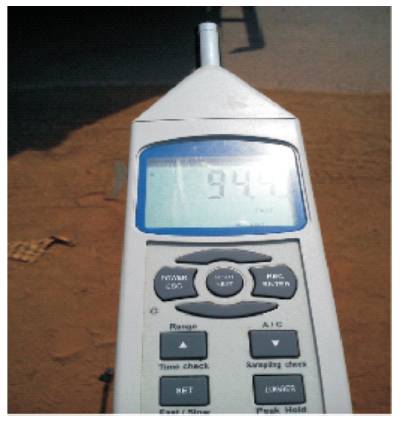
Figure 3. Noise level meter SL-4023SD
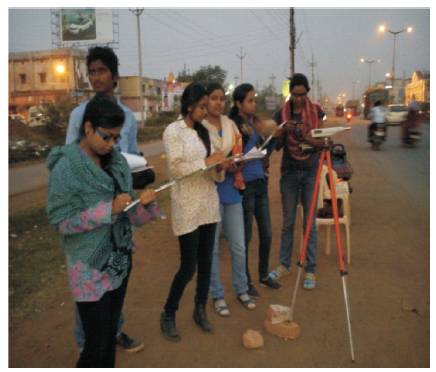
Figure 4. Noise measurement in progress
Noise level assessment was undertaken at location 1 on NH-06 towards Durg to Raipur and also in opposite direction. The group has observed 24 hours day and night noise level, but due to paucity of space 5 minutes sample data of noise level in dB(A) were taken as shown in Table 2 from Durg to Raipur and in Table 3 from Raipur to Durg. Table 4 gives the analysis of noise level data at location from Bhilai to Raipur.

Table 2. Noise Level in dB(A) From Bhilai to Raipur
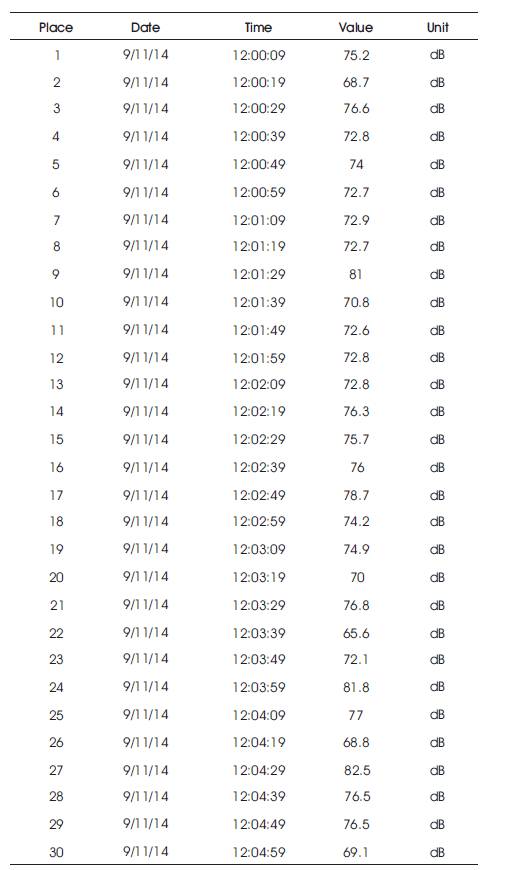
Table 3. Noise Level in dB(A) From Raipur to Bhilai
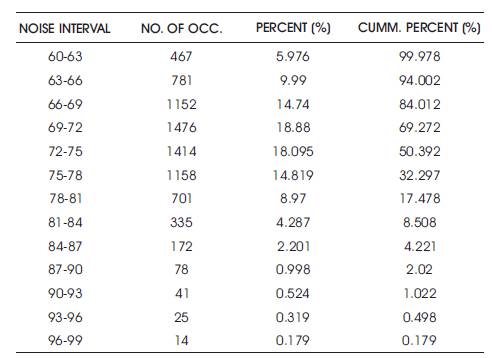
Table 4. Noise Level in dB(A) from Bhilai to Durg
The value of various noise parameters L10, L50 and L90 for 24 hours of observations are obtained by plotting the graph with sound level in dB(A) on X axis as and cumulative percentage of time of the observation period for which that sound level is exceed on Y-axis as shown in Figure 5.
Table 5 gives the analysis of noise level data at location from Raipur to Bhilai.

Figure 5. Cummulative % of time v/s Noise level
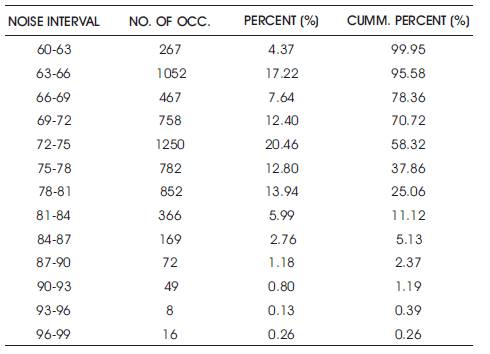
Table 5. Noise Level in dB(A) from Durg to Bhilai
The value of noise parameters for 24 hours of observations are obtained by plotting the graph with the sound level in dB(A) on X axis as and cumulative percentage of time of the observation period for which that sound level is exceeded on Y-axis as shown in Figure 6.

Figure 6. Cummulative % of time v/s Noise level
Based on the analysis of Figure 5, the noise level parameters in dB(A) at location 1 are summarized in Table 6

Table 6. Calculated Noise Levels from the Analysis of Figure 5
Discussion: Acceptable value of L10 as suggested by Langdon [8] is around 66 dB(A). The L10 value determined at location 1 (Durg to Bhilai) was 82.5dB(A) which is higher because of more speed on national highway. Further TNI 97.5 dB(A) and LNP are also found to be high (Shown in Table 6).
Based on analysis on Figure 6 the noise level parameters in dB(A) at location are summarized in Table 7

Table 7. Calculated Noise Levels from the Analysis of Figure 6
Discussion: Acceptable value of L10 as suggested by Langdon is around 66 dB(A). The L10 value determined at location 1 (Durg to Bhilai) was 83dB(A) which is higher because of more speed. Further TNI 101 dB(A) and LNP are also found to be high (shown in Table 7).
L10 value varies with the speed variation. It increases instream spread and vice versa [9]. Impact of traffic with with speed. L10 value is highest as compared to other traffic variable e.g. PCU/Hr.
In India, like many developing countries, the residents of cities are now becoming aware of environmental problems that result from the transportation facilities, in general from road traffic and in particular from automobiles [10]. Traffic problems is a major factor of environmental pollution. Noise affects human body in number of ways ranging from Psychological to Physiological, (e.g. auditor y damage, speech interference, general annoyance, reduces the working efficiency, increases blood pressure & fatigue etc).
This paper presents the measurement of noise on highway, causes of road traffic noise and its effects, and evaluation of important noise level parameters to reduce traffic noise. It has been observed that at NH-06 under study, noise level has exceeded the acceptable limits laid by Central Pollution Board. Further it has been observed that poor surface condition of roads and poor vehicle maintenance/old vehicles are responsible to a considerable extent for higher noise level.
This paper analyzes the measurement of traffic noise on NH-06 and evaluation of important noise parameters. The broad findings obtained are summarized below.
It has been observed that the Equivalent noise level (Leq) has touched the highest noise level standard of 75 dB(A),which crosses the Central Pollution Control Board norms of noise pollution. As Traffic noise index (TNI) & Noise pollution level (LNP) values are high at location (for both the directions) therefore, this fluctuating noise is irritating. The L90 (background noise) is low at location ,therefore, the TNI and LNP values felt more annoying. It has been observed that poor surface condition of pavement surface is also responsible for higher noise level which consequently gives high values of traffic noise parameters.